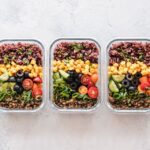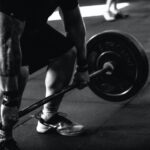
If you want to lose weight and improve your body composition, lifting weights can be one of the most effective ways to achieve your goals.
But how long does it take to see results when lifting weights? And what factors influence the speed of weight loss?
In this article, we’ll explore these questions to help you create a workout plan to achieve the desired results.
Table of Contents (click to expand)
Understanding Weight Loss
Before we dive into the details of weight loss and muscle gain, let’s start with the basics: what is weight loss, exactly?
At its core, weight loss is simply a matter of burning more calories than you consume. When your body is in a caloric deficit, it turns to stored energy sources — including fat — to make up the difference. Over time, this can lead to a reduction in body weight.
Of course, the equation isn’t quite as simple as “calories in, calories out.” Various factors can influence the speed of weight loss, including the types of foods you eat, the intensity of your workouts, and your basal metabolic rate (the number of calories your body burns at rest).
Additionally, different types of exercise- such as weight training, lifting, and cardiovascular exercise- have unique bodily impacts.
Related: How to Use Sea Moss for Weight Loss: The Ultimate Guide
The Benefits of Lifting Weights for Weight Loss
So why choose to lift weights for weight loss instead of other workouts? For starters, resistance training — which includes activities like weight lifting and bodyweight exercises — can help you build lean muscle mass.
Muscle tissue is metabolically active, meaning it burns more calories at rest than fat tissue. As a result, having more lean and muscle mass can increase your basal metabolic rate and make it easier to maintain a caloric deficit.
But that’s not all. Resistance training has also been linked to reduced body fat, increased muscle mass, and improved body composition. One study published in the Journal of Strength and Conditioning Research found that ten weeks of resistance training led to a significant decrease in body fat percentage and an increase in lean body mass among middle-aged women.
Factors Affecting Weight Loss When Lifting Weights
Of course, not everyone will see the same results when lifting weights for weight loss. Various factors can influence the speed at which you can lift weights to lose weight, including:
- Gender: Men tend to have higher testosterone levels, making building muscle mass and burning fat easier.
- Age: As we age, our basal metabolic rate tends to decrease, making it harder to maintain a caloric deficit.
- Starting weight: The more body fat you have to lose, the faster you may see results.
It’s important to address and overcome these challenges to maximize your chances of success. Some strategies to consider include:
- Tailoring your workouts to your fitness level and goals.
- Focusing on compound exercises — like squats, deadlifts, and bench presses — that work for multiple muscle groups simultaneously.
- Using proper form to reduce your risk of injury and maximize the effectiveness of each exercise.
- Incorporating cardiovascular exercise into your routine to burn additional calories and improve your aerobic capacity.
- Creating a caloric deficit by reducing your calorie intake or increasing your caloric expenditure with exercise.
- Prioritizing rest and recovery to avoid overtraining and burnout.
Also read How to Consume White Vinegar for Weight Loss: 20 Simple Ways
How Much Weight Can You Expect to Lose?
So how much weight can you expect to lose when lifting weights? As with most things related to fitness and health, the answer is “it depends.” However, research suggests that a safe and sustainable rate of weight loss is roughly one to two pounds per week. This rate of back fat loss can be achieved by creating a caloric deficit of 500 to 1,000 calories per day through a combination of diet and exercise.
Of course, the weight you’ll lose will depend on various factors, including your starting weight, body composition, and fitness level. Additionally, it’s worth noting that weight loss doesn’t always happen linearly.
You may experience periods of rapid weight loss followed by plateaus or temporary weight gain. This is normal, and tracking your progress over time is so important.
Setting Realistic Goals
Setting realistic goals is essential to maximize your chances of success when lifting weights for weight loss. One common mistake people make when lifting weight is setting overly ambitious, nearly impossible goals. Remember, building muscle and losing fat takes time — they won’t happen overnight.
Instead, focus on creating small, achievable goals to move you toward your more significant objectives gradually. For example, you might aim to increase the weight you can lift by 5% each week or add an extra set to your workouts. By celebrating these small successes along the way, you’ll stay motivated and committed to your long-term goals.
Choosing the Right Weightlifting Program
Choosing the right weightlifting program is crucial for achieving your weight loss goals. Countless programs are available, so finding one that aligns with your fitness level, goals, and preferences is essential. When choosing a weightlifting or strength training program, first consider the following factors:
- Type of program: Do you prefer bodyweight exercises or lifting weights? Are you interested in powerlifting, Olympic lifting, or CrossFit? Many weightlifting programs are available, so choose one that aligns with your interests and goals.
- Frequency and duration: How often will you be training, and for how long? Most weightlifting programs involve training three to five times per week, varying depending on the agenda.
- Exercises: What exercises will you be doing, and how many sets and reps will you perform? Look for a program that includes a variety of compound exercises — like squats, deadlifts, and bench presses — that work for multiple muscle groups at once.
- Progression: How does the program progress over time? A good weightlifting program should include progressive overload, which means gradually increasing the weight or difficulty of exercises over time to ensure continued progress.
Some popular weightlifting programs include Starting Strength, StrongLifts 5×5, and 5/3/1. However, many other programs are also available, so don’t be afraid to try out different approaches until you find one that works for you.
You may also like What is the Best Probiotic for Weight Loss?
The Role of Cardiovascular Exercise in Weight Loss
While weightlifting is a powerful tool for weight loss, it’s not the only type of exercise you should be doing. Cardiovascular exercise — like running, cycling, and swimming — can also be beneficial for burning calories and improving your heart rate and overall health.
The American Heart Association recommends at least 150 minutes of moderate-intensity cardiovascular exercise or 75 minutes of vigorous-intensity exercise per week. This can be done in conjunction with your training program, your weightlifting program, or on alternate days.
Some effective types of cardiovascular exercise for weight loss include:
- High-intensity interval training (HIIT) involves alternating periods of high-intensity activity with periods of lower-intensity recovery. HIIT is particularly effective for burning fat and improving cardiovascular health.
- Steady-state cardio involves maintaining a steady pace for an extended period, like jogging or cycling at a moderate intensity. While it may not burn as many calories per minute as HIIT, it can still be an effective tool for weight loss.
The Importance of Nutrition for Weight Loss
Of course, exercise is just one part of the equation for losing weight and building muscle. Nutrition also plays a critical role in achieving your goals. To lose weight, you’ll need to create a caloric deficit by consuming fewer calories than you burn.
This can be achieved by reducing your calorie intake, increasing your caloric expenditure through exercise, or combining both. When it comes to nutrition, there are a few fundamental principles to keep in mind:
- Focus on whole, nutrient-dense foods: Foods rich in vitamins, minerals, fiber, and other essential nutrients. Examples include fruits, vegetables, lean proteins, whole grains, and healthy fats.
- Avoid processed foods: Processed foods — like chips, cookies, and sugary drinks — are often high in calories and low in nutrients. They can also lead to overeating and weight gain.
- Monitor your calorie intake: Use a food diary or tracking app to monitor your daily calorie intake and ensure you create a caloric deficit.
- Prioritize protein: Protein is crucial for building and maintaining muscle mass, so consume at least 0.8 grams of protein per kilogram of body weight per day (or more if you’re very active).
- Stay hydrated: Drinking plenty of water can help you feel full, reduce cravings, and improve your overall health.
Don't miss How to Make Lime Water for Weight Loss
Combining Weightlifting with Other Forms of Exercise
While weightlifting and cardiovascular exercise are two of the most effective forms of exercise for weight loss, they’re not the only options. Other types of exercise — like yoga, Pilates, and dance — can also be valuable tools for achieving your goals.
Incorporating different types of exercise can help keep your workouts interesting, prevent boredom, and challenge your body in new ways. Some examples of how to combine different workouts include:
- Alternating between weightlifting and cardiovascular exercise on different days.
- Incorporating yoga or Pilates on rest days to improve flexibility and core strength.
- Add a dance class or other fun weekend activity to stay active and burn extra calories.
Common Mistakes to Avoid
A common mistake people make when trying to lose weight is overlooking the role of nutrition. Weightlifting alone will not cause weight gain or muscle mass loss. You need a balanced diet that provides the necessary nutrients to fuel your workouts and recover afterward.
Another mistake is overtraining, which can result in injuries or the body going into a catabolic state, breaking down muscle tissue for energy. Ensure that you allow for proper recovery times between workouts to avoid this.
Lastly, many people focus solely on the scale and get disheartened if they don’t see it decreasing. Remember that muscle weighs more than fat, and lifting weights makes it possible to lose fat while gaining muscle mass.
Overcoming Plateaus
Plateaus are a natural part of any weight loss journey. Over time, your body becomes more efficient at performing the same exercises, meaning it burns fewer calories. To overcome this, try changing your routine or increasing the intensity of your workouts.
Another strategy is to adjust your diet. Perhaps you’ve been eating the same amount of calories since starting your weight loss journey, but your caloric needs might be lower now that you’ve lost weight.
Maintaining Muscle Mass
Maintaining muscle mass is critical during weight loss because muscles help burn calories even when not exercising. Protein plays a vital role here as it provides the muscle building and blocks your body needs to repair and build muscle tissue.
Resistance training, such as aerobic exercises such as lifting weights, is crucial in preserving and building muscle mass. Combine this with adequate protein intake, and you’ll set yourself up for success.
Related Article What Beans are Good for Weight Loss
Monitoring Body Fat Percentage
Monitoring body fat percentage is a more accurate measure of progress than weight alone. It provides a clearer picture of your composition—how much is muscle and how much is fat.
Several ways to measure body fat percentage include skinfold calipers, bioelectrical impedance scales, and DEXA scans. Whichever method you choose, consistency is key. Measure under the same conditions each time for the most accurate tracking.
Staying Motivated
Motivation is a critical factor in long-term weight loss success. Set achievable goals and celebrate when you reach them. Find a workout buddy to help keep you accountable, or consider hiring a personal trainer.
Remember to focus on how you feel, not just how you look. Noticing improvements in strength, stamina, and overall well-being can be highly motivating.
Celebrating Success
Celebrating your successes, no matter how small can be incredibly motivating. This could be as simple as treating yourself to a new book, massage, or spending time with loved ones. The key is to choose rewards that align with your fitness goals and provide positive reinforcement.
Dealing with Setbacks
Setbacks are inevitable. The key is not to let them derail your progress. Instead, view them as learning opportunities and adjust your plan accordingly.
Remember, it’s okay to have off days. If you overindulge one day, don’t beat yourself up. Just aim to make healthier choices the next day.
Final Thoughts
Weight loss while lifting weights is a balancing act that involves careful attention to diet, adequate recovery, and regular exercise. Monitoring your progress through measures like body fat percentage rather than weight alone can provide a more accurate picture of your progress.
Remember, motivation will wane, and setbacks will happen. The key is to stay consistent, celebrate your successes, and learn from any hurdles you face. You’re on a journey, not a sprint, and each step you take brings you closer to your goal. Keep going—you’ve got this!


































